Mealtime Partners, Inc.
Specializing in Assistive Dining and Drinking Equipment
May 2010 Independent Eating and Drinking Newsletter
 |
May Topics: |
||
|
Mealtime
Partners Home Page Send a Comment or Suggestion |
|||
The Social Aspects of Mealtimes
Have you ever considered how differently people behave at mealtimes? When families eat at home, some people like to talk during a meal, others prefer to eat without much social interaction. Children are encouraged to eat rather than talk. Some families have the television on during meals which distracts them from having conversation. However, mealtimes are generally thought of as a social time. If family or friends go out for a meal together, normally there is a constant flow of conversation going on throughout the meal. In fact, often people will remain sitting at the table after they have finished eating to continue their conversation.
If you are unable to self-feed, being social during a meal can place you at a higher risk of choking. Many people who are fed do not actively participate in the conversation at mealtimes; they are passive participants, listening and making minor comments, but they do not become fully involved. This is a natural evolution of being fed because when you are fed you are never entirely sure of when a bite of food will be put in your mouth. The person feeding you might think you are opening your mouth for a bite of food when you are really intending to speak. This removes the spontaneity of participating in a conversation. This situation is exacerbated when you are being fed by someone who is either unfamiliar with you (a new personal attendant or certified nurses assistant), or who is in a hurry.
Social interaction at mealtimes is not only a pleasant experience but additionally leads, indirectly, to slower food consumption. This provides an indirect health benefit, as slower eating lessens the likelihood of indigestion and reflux. If you are responsible for feeding someone, remember, the quality of their mealtime experience is impacted by your interactions with them. Take the time to be social and allow them the time to talk without the concern that they will be given a bite of food. To signal that you will not going to serve a bite of food, place the utensil on the plate or bowl and remove your hand.
Bon appetite!
|
Socializing when Eating:
The
Mealtime Partner Dining System was designed with safety as
the highest priority. However, great consideration was also
given to allow those using it, the ability to fully
participate in the social aspects of meals. As a result, the positioning of
the device is offset to the right of the user and allows
the user to be able to see those sitting around them
at the dining table. This is another of the many unique features
that makes the Mealtime Partner the leader in assistive dining.
In addition, the flexible mounting and positioning capabilities of the Mealtime Partner meets a diverse range of user needs, including wheelchair users and those who do not sit at a table to eat. The Mealtime Partner is very patient. It will never rush the eater into taking the next bite, leaving plenty of time for socializing. |
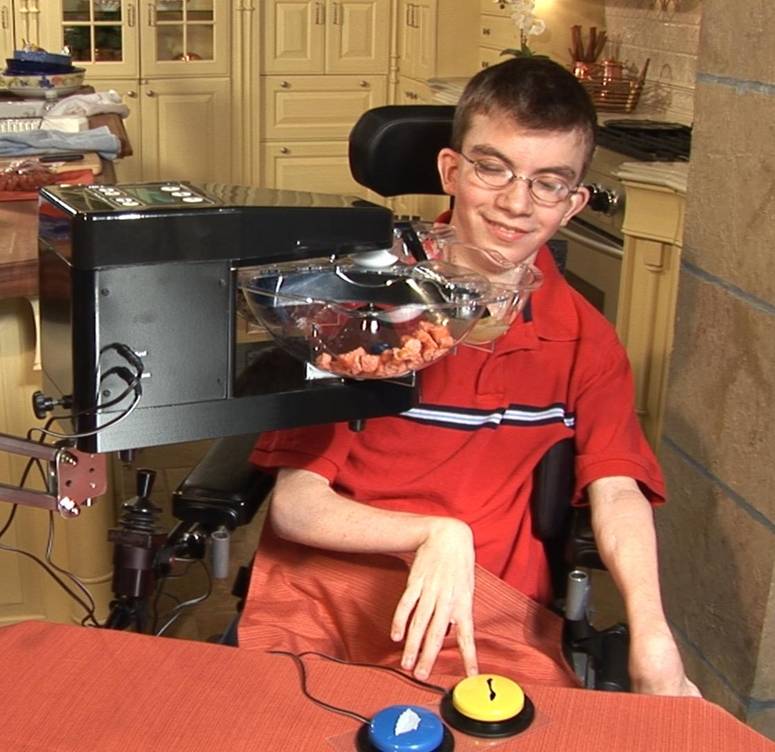 |
| For more information about the Mealtime Partner Dining System, you can visit the Mealtime Partners' website, or view our 4 minute video. | Offset positioning promotes greater socialization |
Promoting Self Feeding
For people who, due to disabilities, have never been able to feed themselves, learning to do so can be a slow and difficult process. For those who are unable to eat independently, a major goal for them should be to acquire the ability to self-feed because it is safer than being fed and it can also enhance the feeling of well-being and independence.
The first effort made to acquire independence should be to have the individual feed him or herself with a spoon, in the traditional manner. Sometimes to accomplish this requires the use of special equipment, known as assistive technology (AT), to make the task of eating less demanding. Some of the least sophisticated AT is described later in this article. However, after making every effort to facilitate the individual feeding themselves using their hand and arm to lift a spoon to their mouth, if the individual is still unable to self-feed, then more advanced AT should be considered. First, none powered feeding devices that control the arm and hand movement should be evaluated. If they do not work, a fully powered dining system (which is, of course, Mealtime Partners' specialty) should be assessed for that individual. Regardless of the level of AT that is needed to successfully self-feed, the goal should be to provide independence at mealtimes, if at all possible. This newsletter topic will focus on the more traditional manner of feeding ones self, with or without utilizing AT.
Feeding oneself in the traditional way involves a number of steps, and the use and coordination of many muscles. Mastery is not easy and it should not be expected to be acquired rapidly or without great effort. It is recommended that, even though food stays on a fork more easily, that a spoon be used by individuals who might “miss” their mouth while learning to eat. A fork can poke and hurt the person and make them apprehensive of the whole experience of independent eating.
To understand how to facilitate self-feeding, the task should be broken down into the individual steps that comprise the entire act of taking a bite of food. Once these steps are identified, it is wise to make them as easy as possible for them to achieve. The following will provide a brief discussion of each of the steps and methods to make them easier for the eater:
1. Grasping and maintaining a hold on the spoon handle.
2. Loading food onto the spoon.
3. Keeping the spoon on a level plain after food is loaded and raising it to the mouth.
4. Inserting the spoon into the mouth.
5. Closing ones lips around the bowl of the spoon.
6. Removing the spoon from ones mouth.
7. Returning the spoon to the bowl.
1. Grasping and maintaining a hold on the spoon handle. For individuals who have low muscle tone, holding the handle of a utensil is challenging. A larger surface, like a built up handle on a utensil can make this easier. A cuff can be used to attach the utensil to the hand. There are a wide variety of cuffs on the market and the one that best accommodates the function of the user’s hand should be selected. If wrist control is weak, a wrist support with a cuff would be a better choice than just a cuff.
A few of the many dining aid products are pictured below. Whenever a selection is available, Mealtime Partners recommends selecting unbreakable plastic utensils, or metal that is coated with plastic, rather than plain metal utensils, for the greatest safety.
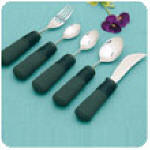 |
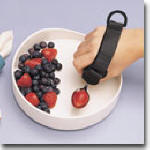 |
| Utensils with Enlarged Handles | Using a Spoon with a (black) Cuff |
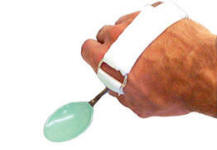 |
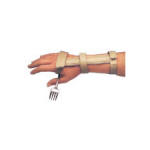 |
| Eating Cuff Holding Utensil | Wrist Support with Eating Cuff |
2. Loading food on to the spoon. Foods that stick to a spoon, like yogurt, pudding or thin mashed potatoes, should be used when first learning to feed oneself. This provides some food to the user while they are learning how to reliably pick up food, and maintains their interest in learning rather than them becoming frustrated by the lack of success at acquiring food. It is advisable to only practice independent eating when the person learning is not very hungry. When hungry, frustration can interfere with learning. A scoop dish helps get food onto a spoon more easily than a standard bowl or plate (but a bowl is preferable to a plate if a scoop dish is not available). The location of the scoop edge makes a significant difference in the action required to load food onto a spoon. If the scoop edge is facing towards the back (away from the user) the user will push their hand away from the body in an arm extension movement. However, if the scoop edge is facing forward (close to the user’s body) the hand action is towards the body, closing the bend of the elbow. This is a significant difference, and depending upon the user’s muscle tone and control, the scoop edge should be positioned to accommodate their most productive and repeatable muscle movement. Placing the dish on a sheet of Dycem will help hold the dish in place.
 |
| The Scoop Dish |
3. Keeping the spoon on a level plain and raising it from the bowl to the mouth. To be able to feed oneself a wide variety of foods, it is essential that food stays on the spoon once it has been scooped. For this to happen the bowl of the spoon must be kept level as it is moved from the bowl to the individual’s mouth. This requires that the wrist, elbow and shoulder make subtle adjustments to the angle of the spoon as it is moved. This is a highly complex series of actions and is often too difficult to execute, and, as a result, the food spills off of the spoon. Several things can be done to simplify this task. First, eliminate the need for raising the spoon from the bowl to the mouth by positioning the bowl on a raised surface at (or near) mouth level. This can be accomplished by using an over-the-bed table or by placing a box of the appropriate height on the table. The box must be large enough to hold the bowl and allow the user to rest their elbows and lower arms on it. With this arrangement the user must only move their hand forward and backward, not up and down. The spoon can be loaded and moved to the mouth on (approximately) a single plane. To make this even easier, the scoop edge of the bowl can be angled either to the left or right and slightly forward, towards the user. This allows a sweeping movement of the spoon to brush against the scoop and load the spoon and the same movement to continue to the mouth. As the user acquires competence with this movement, the surface can be gradually lowered, increasing the complexity of the task very gradually as they learn greater control.
4. Inserting the spoon into the mouth. This might seem a very obvious part of eating, however, if you have always been fed, it is by no means obvious. If someone has always put the spoon into your mouth for you it is not intuitive to do it for yourself; it is a new experience and must be learned. Verbal prompting may be helpful to encourage independently putting the spoon into the mouth. Finding ones mouth with the spoon is an additional undertaking. Often the mouth is missed entirely or it takes several attempts to access it. Practice may improve this skill but those who have tremors, or other involuntary movements, will always find it difficult. Stabilizing the elbows and forearms (described earlier) makes it easier to access your mouth with a spoon. Arm/hand movements should be analyzed to evaluate whether gross movements or fine motor movements are easier for the individual to execute. This will help establish how to configure the dining environment to allow the user to get the spoon into their mouth with the least amount of stress.
5. Closing ones lips around the bowl of the spoon. Once again, it appears obvious to follow putting a spoon in your mouth with closing ones lips, but for those who have been fed all of their lives, it is not an automatic response. Many caregivers wipe the food off of the spoon, into the mouth, using the person’s front top teeth as a wipe edge. When this is the normal pattern of eating, the individual being fed holds their mouth open, rather than closing their lips over the spoon. When independent eating of any kind is introduced (self feeding or with assistive technology) the individual must learn to close their lips to remove the food from the spoon. First try verbal prompting. Both verbal and physical assistance may be needed to moderate this movement. If verbal assistance fails to achieve the desired results, physical assistance can be provided by gently helping the person close their lips over the spoon with your fingers. Repeat this help as many times as necessary. Remember to allow the individual, who is learning, plenty of time to attempt to independently create lip closure, prior to assisting them. It takes time, both cognitively and physically, to close your lips when it is a new experience.
6. Removing the spoon from ones mouth. When the spoon is in your mouth and your lips are closed around it, the next step is to remove the spoon from your mouth. The lips should be slightly relaxed but they should not be opened. This allows the spoon to be removed while the food remains in the mouth. Opening the mouth wider will allow food to fall out of the mouth or for the food to simply remain on the spoon. Physical assistance with holding the mouth gently closed can help the individual learn what they must do with their mouth when removing the spoon if verbal prompting alone does not work. Also, the individual must learn to coordinate their mouth movement with the hand and arm action necessary to remove the spoon from their mouth.
7. Returning the spoon to the bowl. The final step in completing the sequence of taking a bite of food is to return the spoon to the bowl. The action of removing a spoon from ones mouth tends to create an exaggerated arm movement that pulls the arm away from the body. Verbal or physical assistance may be needed to moderate this movement. If some food is remaining on the spoon, this movement might cause some spillage. Using a vinyl table cloth under the person’s chair can make clean-up easier. Practice will lessen or eliminate these problems.
Feeding oneself is a complex undertaking and within each of the seven steps described above are many demanding sub-tasks. For many individuals, independent eating is a strenuous activity that burns a great number of calories. Additionally, because it is such a demanding job, it can tire the individual. All of these aspects must be considered when looking at the long term goal of mealtime independence. Does the individual burn excessive calories feeding themselves? If so, they may benefit from assistance from a caregiver for part of a meal. Or assistive technology, like the Mealtime Partner Dining System, could be used to allow them to be fully independent in eating, while reducing the number of calories burned while eating.
Remember eating should be enjoyable and if it becomes a struggle, the pleasure of the experience is diminished. Feeding oneself by hand, does not have to be abandoned because it is difficult or tiring but it can be supplemented with the right equipment. A thoughtful blending of eating methods can provide a higher quality dining experience without sacrificing dignity or independence.
| A Mealtime Partners Tip:
Create a quiet mealtime environment. For individuals who are
easily distracted or who have involuntary movements, a quiet and
calm dining room can make eating less effortful. Sudden, loud
noises or people moving around, makes concentrating on the meal
difficult. Avoid having a television on during meals, and only
have soft background music. We want your feedback! If you have comments or suggestions to expand and/or clarify the information in our Newsletter articles, please feel free to email us at: newsletters@mealtimepartners.com. Comments from our readers help us provide better, more complete information to the community that we serve. |
Mealtime Partners Website Navigation:
Home | Dining | Drinking | Products | Ordering | Training | Calendar | FAQ | Newsletters | Contact
Please send comments and suggestions to newsletters@mealtimepartners.com
Copyright © Mealtime Partners, Inc. 2010
All rights reserved.